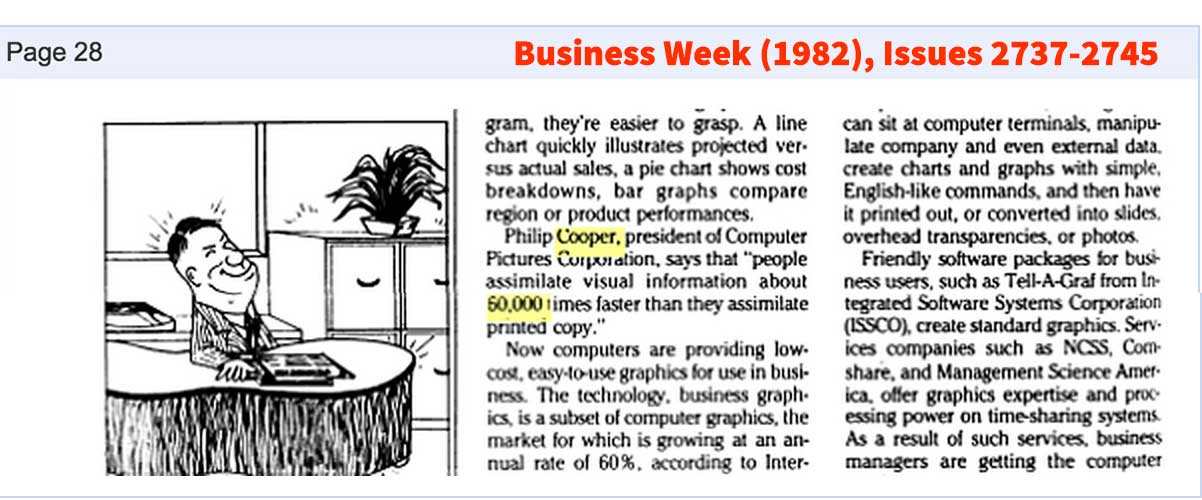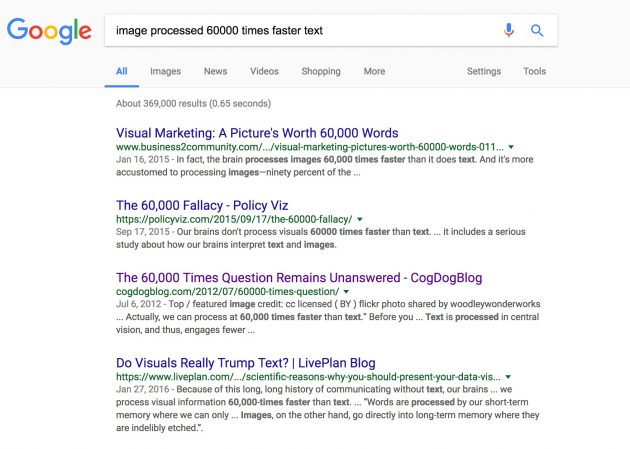If you are attending the NMC 2017 Summer Conference in Boston, I have a media/fake factoid challenge for you. By taking it on you can finally solve a vexing (what I believe is a) chimerical myth.
And you can win CASH money.
I have been chasing down this media myth since 2012, the oft repeated, ever powerpointed, book printed “fact” that “humans process images 60,000 times faster than text.
I’ve been at it a while (the 2001 3M reference is a shimmering illusion, it is just a brochure) in a series of blog posts. Readers have peppered presenters who insist on echoing the claim.
Still to date, there is no documented study, research, or even person who can cite the origin of this claim.
Doesn’t this keep you up at night?
I have chased this beast back to 1982, the earliest claim I have found is a 1982 ad insert to Business Week attributed to Philip Cooper, then president of a media company.

Cooper is currently a Senior Lecturer in Finance at the MIT Sloan School of Management. Over the years I have emailed Cooper, left voicemail messages, reached out to his office assistants. I am pretty sure he knows where this came from.
But he is hiding from me.
I’ve asked colleagues who work in Boston (I won’t embarrass you by naming names) but none have taken up the challenge.
I also put a $60 prize out for the person who can finally get to the bottom of this, and I have doubled that to $120.

Cold cash.
So what does this have to do with NMC?
Their summer conference is June 13-15 in Boston. MIT is across the river in Cambridge.
So if you are going to the NMC Conference, maybe you can skip a session and track down Philip Cooper. You could end this mystery easily and go home with $120.
I will take as proof an audio recording or written word from Cooper identifying the source of the claim he made in 1982. A photo of you and him would be a bonus. Heck, I will toss an extra $20 for a selfie with Cooper.
Surely someone at this conference has the gusto to do something that will settle an ongoing, repeated claim that, as far as anyone has found, no factual basis beyond repetition on the internet.
It’s been said almost 370,000 times
Yes there is zero documented sources to back the claim.
So there is is, NMC Conference attendees, I am giving you a mission, and maybe cash. Imagine the bragging rights you can claim.
I triple dog dare ya to find Philip Cooper and get to the bottom of this.
Featured Image: Modified from Feiring av EL60000 i Norge flickr photo by Elbilforeningen shared under a Creative Commons (BY) license by inserting NMC’s logo on the flags. Sorry.



What bugs me about the image-vs-text thing is that we perceive text in the same way we perceive everything else – as patterns of signals triggered by photosensitive cells in the retina. Pattern recognition kicks in, and we think “hey, that’s a tree.” Or “hey, that’s the word ‘tree’.” It’s not like we have a serial port for text input that bypasses this sensory process. Printed information (text) _is_ visual information. Cooper and his ilk got hung up on the “the brain is a computer” trope, which is false (same with “the brain is a pneumatic system” or “the brain is a clock” that came before, and, likely, “the brain is a quantum computer” or whatever will come next. No. The brain is the brain. It’s awesome. Analogies and metaphors may help explain our understanding of how it works, but that doesn’t magically turn it into whatever we compare it with today…)
I totally agree that it was a faulty comparison from the start, not even comparable.
But it makes such a great slide.
I was invited to NMC2017 but I decided not to go. Regretting that now – as the £ is plummeting faster than the $ 120 greenbacks is a lot of money…
I can’t speak to the 60,000 number but I suspect that the argument itself traces back to the work of Stephen Kosslyn and work with mental imagery.
Here’s a (partial) description of Kosslyn’s work (which I think will have to be revised at a future date, for completeness and clarity).
The argument is based on the idea of whether we perceive and process information symbolically, using rules, or visually, using quasi-) mental images. Kosslyn had subjects visualize rotating a cube in their minds and had them report back; he then measured the time it would take to do this. He found that there is a symmetry in the time it takes to rotate a cube mentally, and to rotate one physically.
In response, supporters (Jerry Fodor, Zenon Pylyshyn) of the alternative view (aka the physical symbol system hypothesis) argued that the rotation was the result of thousands of iterations of rules. So one mental image would be the equivalent of thousands of sentences. This is what is needed to explain the symmetry.
This argument generalizes, as you can see how you need thousands of lines of ‘mental code’ to simulate dynamic visual and audio mental phenomena such as images, and this then tracks back to perception as well.
There’s probably a story of embellishment and false precision between these sorts of studies and the figure claimed in the article. And how this makes the leap to the visual processing of printed text I can’t say.
Thanks Stephen, the timing of Kosslyn’s work might be what Cooper may have been picked up and somehow yanked that 60,000 number out of the air. I really want to know that specific source, and there is a man in Cambridge who knows. Then it’s a mystery jump to how 3M put it in a brochure citing “internal research” in 2001 though never specified. Darren Kuropatwa got close by finding a reference in an earlier presentation in the Philippines by a 3M exec.
Until I hear of where exactly the 60,000 times fast originated, the $120 prize remains in my wallet.
Too bad NMC seems un-interested in picking up the challenge.
Cogdog – the Paul Erdos of random factoids
What about this article:
http://misrc.umn.edu/workingpapers/fullpapers/1986/8611.pdf
This is after the 1982 news clipping, but still relevant.
It’s relevant but not even close to the claim. The paper, a rather limited subject study, concludes a 43% increase in persuasion, and nothing about perceiving visual information faster than text.
But just to be more clear, I contacted Doug Vogel by email to which he replied:
So sorry, related not quite relevant. Thanks anyhow!
Hello, Alan. I am fascinated by the data point, and I actually tend to believe it, but I too will not be satisfied until I find the source. To D’Arcy’s point and your reply, I can provide examples where a visual display can be absorbed and understood more quickly than a paragraph of words, but perhaps at another time. More pressing: Not sure if you have seen Allen Newell’s 1973 commentary on the presentations and studies in W.G. Chase’s “Visual Information Processing.” I have a copy I can send to you, if that would be helpful.
Intriguing. I am on this quest with you!
Paul
I’m happy to have you on the hunt, Paul.
I have no problem with the assertion that humans can process visual information faster than written. Why not just say it’s faster w/o having to hang it on words that sound only factish. I object to the reaffirming this without questioning it, and that it is a claim lacking a source.
But bring it on! Find me an answer, and that $60 prize could be yours.
Thank you for great content. A further question, about the source of the research into how the human mind processes visual information 60,000 times faster than text-based information. I am inclined to believe that, for various reasons, but I have yet to find the actual research that demonstrates it. I noticed in a comment Amy Balliett of Killer Visual Strategies posted in 2019; she gave the best answer – citing Michael Gazzaniga’s book “Nature’s Mind” (1992) and Allen Newell’s book “Unified Theories of Cognition” (1990). Both are well-respected scientists in their respective fields of neuropsychology and cognitive science. But I was not sure if either of them had conducted the original research, or if they were citing someone else’s earlier research. I could consult those books to find out, but I thought I would ask you all first, in case anyone has found the answer yet. I am more concerned with the truth, than the $60…. Thank you in advance for your reply!
Joining you on the quest for truth, expressed visually,
Paul Radich, Ph.D.
P.S. Not sure if you have seen Allen Newell’s 1973 commentary on the presentations and studies in W.G. Chase’s “Visual Information Processing.” I have a copy I can send to you, if that would be helpful. Intriguing.
Thanks for sharing these references, Paul, and yes, I’d be interested in seeing them. And I agree that somewhere there might be research this was extrapolated from.
As suggested early in the hunt, I was able to contact Doug Vogel who co-authored a 1986 paper Persuasion and the Role of Visual Presentation Support: The UM/3M Study which offer it’s own repeatable mantra
And it has the research data right there, but is even that worth extrapolating to the 2022 mediascape? When you read the methodology (which was fine for the scope of the study) I have much trouble extending that conclusion everywhere. (Vogel repplied to the email saying the 60000 times claim was not from his work).
Also never questioned is what the assertion even means for perception, what does “information processed visually versus text” really entail? re we talking comprehension, understanding, pattern matching?
But thanks for joining the cause, and maybe those 60 clams could be yours!